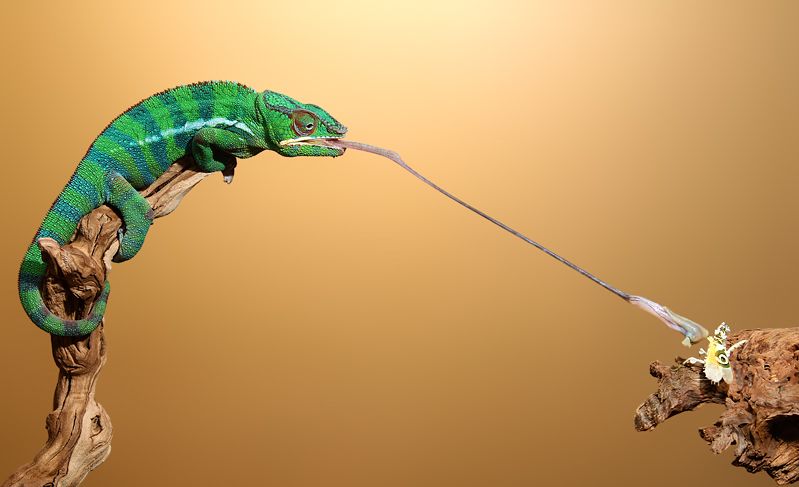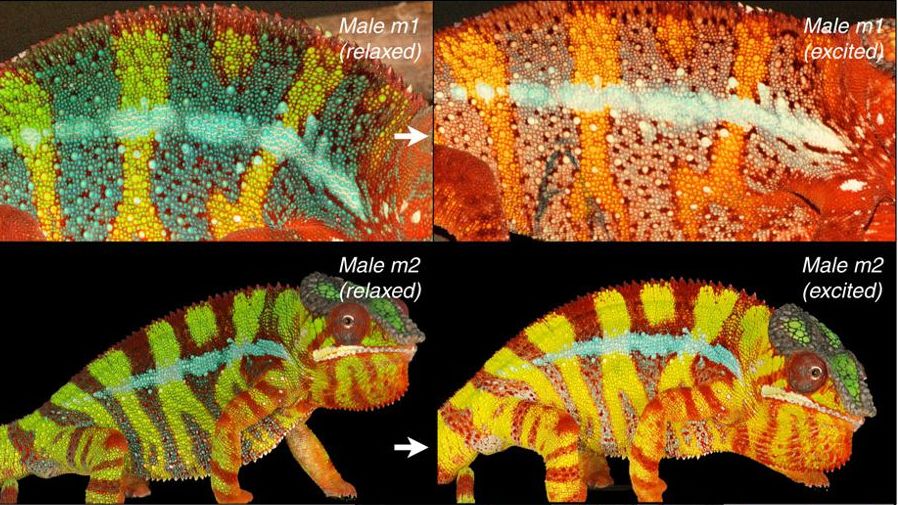Chameleons
Article curated by Joshua Fleming
There are over two hundred species of Chameleon; a lizard that lived in the ‘Old World’ when there was probably only three continents. These ancient animals hold a fascinating blend of traits that scientists have been studying for many years. Breakthroughs in several areas of chameleon research have answered questions, but also founded new research areas with new questions...

Colour changing
Probably the most defining characteristic of the chameleon is colour changing. These transformations can be both rapid and incredibly complex – exactly how the camouflaged creatures do this is not fully understood. Chameleons change colour for several reasons. It acts as a social signal; male chameleons show light, bright multicoloured patterns when attempting to court females, but turn much darker shades if they are angry or trying to appear intimidating. Some chameleons also use their ability for camouflage, and others for absorbing and reflecting heat depending on the time of day.
Chameleons have structural colours and pigments. The latter, now found to be mostly yellow, is like a skin ‘stain’, which scientists used to think was dispersed in different ways to change the chameleons’ appearance. However, we now know that chameleons have two layers of cells called iridophores within their skin[1]. The top layer is responsible for colour changes. Iridophores contain layers of nanocrystals which reflect light and produce the mesmerising colours we see on their skin. To change from one colour to another, the chameleon has to change the structure of these nanocrystals, which then reflect light differently, creating new colours. We don’t know how the chameleons control their nanocrystal networks, or how they developed in the first place.
Researchers discovered in 2015 that a calm chameleon has a tight packing of nanocrystals on their skin surface[1]. This structure reflects blue light and so, mixed with yellow skin, the chameleon looks green. But when its mood becomes more active, the crystal lattice loosens and then red and oranges are seen. The second layer of iridophores is less well organised; this layer seems to work to block the sun's rays, preventing the chameleon from overheating.



A chameleon’s tongue is one of the most bizarre in nature. It has a cylindrical end, literally engulfing their prey before it’s even been pulled back into the mouth. Firing out and accelerating over 41 Gs (the maximum a human has reached on a rocket sled is 46.2 G), reaching nearly twice its body length, and hitting prey in less than a second – it is a fearsome weapon, one of the fastest tongues on Earth. But because that sheer amount of force and power can’t actually be produced by a muscle, scientists aren’t certain as to how it works[2].
The prevailing theory is the use of an elastic recoil mechanism. A 2004 study became the first to provide evidence for this mechanism; however, no further studies have been carried out, despite the fact that the original paper lacked experimental physiological data[2]. Elastic recoil has been studied more recently in several types of fish, but it remains unresolved whether this mechanism is responsible for the movement of the chameleon tongue.


Chameleons have long been thought to have independent eyes; unlike humans they can move them in different directions separately and seemingly randomly. This ability, called voluntary strabismus, was tested by getting chameleons to play a computer game, where they were shown a double image of an insect[3]. Each replicated insect moved in opposite directions and the chameleon tried to catch one with it’s tongue. Researchers found the chameleon would focus with one eye first on one image, before deciding to go for the insect. If the eyes were truly independent with regard to co-operation, they expected the other eye wouldn’t play a role. However, the second eye snapped round to focus on the same insect as the first eye. Scientists think that this means the eyes are, in fact, cooperative. This is like how our hands work. If our hands moved truly independently, tasks like typing would be impossible! But we can type one-handed, which looks just like our hands are independent.
Scientists think some sort of cross-talk occurs, where each eye knows what the other is doing; movements are coordinated, but individual. When a point of interest appears, they cooperate. This is one of the first examples of this behaviour to be studied comprehensively; we don't yet know whether this theory may be extrapolated to other species, e.g. bird binocular vision.


 2
2_-_lateral_view.png)


 2
2This article was written by the Things We Don’t Know editorial team, with contributions from Ed Trollope, and Joshua Fleming.
This article was first published on 2018-11-10 and was last updated on 2021-04-19.
References
why don’t all references have links?
[1] J. Teyssier et al. (2015). Photonic crystals cause active colour change in chameleons. Nature Communications. 6(1). doi: 10.1038/ncomms7368.
[2] J. H. de Groot, J. L. van Leeuwen (2004) Evidence for an elastic projection mechanism in the chameleon tongue. Proceedings of the Royal Society B: Biological Sciences. 271(1540): 761-770. doi: 10.1098/rspb.2003.2637.
[3] H. K. Katz et al. (2015). Eye movements in chameleons are not truly independent – evidence from simultaneous monocular tracking of two targets. Journal of Experimental Biology, 218(13): 2097-2105. doi: 10.1242/jeb.113084.
[4] W. M. King, and W. Zhou (2000). New ideas about binocular coordination of eye movements: is there a chameleon in the primate family tree?. The Anatomical Record: An Official Publication of the American Association of Anatomists, 261(4), 153-161. doi: 10.1002/1097-0185(20000815)261:4.
[5] W. M. King (2011). Binocular coordination of eye movements–Hering’s Law of equal innervation or uniocular control? European Journal of Neuroscience, 33(11), 2139-2146. doi: 10.1111/j.1460-9568.2011.07695.x.
Recent chameleons News
Get customised news updates on your homepage by subscribing to articles











